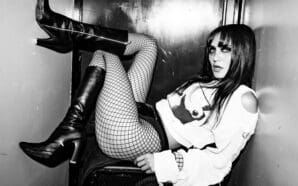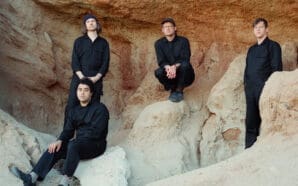St. Louis-residing, Chicago-born Sleepy Kitty are yet another delightful band of recent history that has repositioned a hero of ‘90s alt rock as a contemporary and fresh musical force to be reckoned with… at least for those with taste. Sleepy Kitty is comprised of former Harvey Danger drummer Evan Sult (who handles skins, vocals, and tapes) and Paige Brubeck (who’s in charge of vocals, guitar, and keys). The two met post-Harvey Danger in Chicago when Evan was playing in Bound Stems and Paige was balancing art school with being a local musician. Their debut, Infinity City, came out in 2012 and their follow-up, Projection Room, was released early this year. The album rings of garage surf rock, equally informed by Americana and the ‘90s most poignant alt rockers and singer/songwriters. It’s pretty and badass… and pretty badass. It contains an abundance of indie pop post-balladry, both legitimately sunny and legitimately sincere. It sounds perfect for soundtracking intellectuals slow-dancing, but is actually existentially quite a bit headier and heavier than that. They recently premiered their music video for “Don’t You Start” and I recently got a chance to have a lovely chat with Paige Brubeck about Sleepy Kitty’s origins, sounds, and fondness for high-end cinema.
Izzy Cihak: First off, how did the two of you come together as a band? There’s not a ton of info available about Sleepy Kitty.
Paige Brubeck: We met in Chicago when Evan was playing in a band called Bound Stems and I was going to School of the Art Institute Chicago and playing in my band, Stiletto Attack. We started playing together purely for fun and playing weirdo stuff that our other bands weren’t as interested in doing. It was a lot of experimental sound collage stuff that I was working on in art school in the beginning, but eventually became a full-fledged band.
Izzy: You released your second full-length, Projection Room, early this year. What have been the highlights of promoting it, thus far?
Paige: Our record release party was really fun. We did a listening party at the St. Louis Science Center’s planetarium with a laser show choreographed to Projection Room, so that was pretty amazing. I love touring too, so getting in the van and going to cities we love and finding out about new places is great. About a month ago we played a great festival called In It Together Fest in DC of mostly house shows. We had a particularly great time in Dayton, OH and in Detroit too.
Izzy: Have you had any particular favorite reactions to it, whether from critics or fans, friends, or family?
Paige: Overall I’ve been really happy with the response. Most of our friends and family who liked Infinity City have said they like this one even more and that it’s a big next step, which is great because you always want to be moving forward.
Izzy: How do you think the album compares to Infinity City, both in terms of the evolution of your sound and just the process of writing and recording it?
Paige: I think in a lot of ways, even though its style varies a lot, Projection Room is a more focused album. Infinity City was a lot of catching songs that I came into the band with and had previous versions and ideas of. We were that much newer of a band then, so we were still kind of learning how to work together. On Projection Room we already know that Sleepy Kitty is a band and what kind of things we do together so I feel like it has a stronger foundation. Also, it has more guitar solos. I couldn’t play them at the beginning of the writing process and by writing that way I learned how to play that way.
Izzy: Do you have a favorite album track, whether one you’re most proud of, or just one that you think is especially fun to play? As much as I want to like “Godard Protagonist Inflection” the most, I definitely have to say “The Hoax” is my favorite song on it.
Paige: “Godard…” is certainly one of my proudest moments on the record. It was a major beast to tackle and required a lot of trust from Evan and the engineer on the song. I’m really pleased with “What Are You Gonna do When You find Bigfoot?” too. That came out of a conversation about a film Evan and I had seen and he really helped us catch it lyrically. I really like the production on that one as well. I got to go nuts on harmonies and I think the swamp sounds at the end really make it. I feel like things get a little magical each time I hear the ending, especially live when the audience joins in on Bigfoot calls.
Izzy: Between the album’s title, the Godard reference, and your super cool music videos, film is obviously a big influence on this project. So, I’m curious, what film movements, filmmakers, or just films themselves, do you find to be most inspiring?
Paige: Film is super inspiring to us. I was in the Film/Video department at SAIC so video installation and animation are things I think about a lot still. Godard, obviously is huge to us. We love Hitchcock and Woody Allen too (especially the early stuff.) The new Gondry film, Mood Indigo, is amazing and has been stuck in my brain since I saw it. Akira Kurosawa’s Dreams has been a big influence on me. I’m a big fan of Tony Oursler, Bruce Naumann, and Matthew Barney too in the art world side of things. I think one of the reasons I keep coming back to Godard though is that he really walks the line of art world and cinema world.
Izzy: Are there any films or filmmakers that you think are drastically under-appreciated that you think people need to check out. (I can’t, for the life of me, figure out why William Klein’s Who Are You, Polly Maggoo? doesn’t achieve more critical praise. I think it’s easily as good as, if not better than, any other New Wave film, but communist, socialist, and anarchist punks kind of seem to be the only ones who get it.)
Paige I’ll definitely have to check out Who Are You, Polly Maggoo? I know it’s one that often the people who know about it love it, but not enough people know about it, La Jetée by Chris Marker is one of the most amazing filmic experiences I’ve had.
Izzy: It’s really funny that that’s the first thing you brought up, because William Klein is actually in La Jetée as an actor. He was buddies with Marker, Varda, Resnais, and all the other Left Bankers.
Paige: In the more mainstream side of things, I may be the only person who thinks that I Heart Huckabees is David O. Russell’s best film. I really love that movie. It’s definitely one of my favorites. I had some issues with the editing of the dance sequence of Silver Linings Playbook. I think Huckabees is fantastic though. Also, something that used to be huge but the further we get from the 20th century the less people know about it: Busby Berkeley. People often refer to a “Busby Berkeley” treatment, like the scene in The Big Lebowski, but when you really see his thing in context it’s clear that he was an unmatched genius. There’s never been anything else like it. You can look up the dance sequences on YouTube, but I think they’re best in the context of the films. After really getting into the world of the films (that are basically in another language because they’re ’30s Hollywood) it’s so trippy and magnificent and disorienting when these huge arrangements seem to come out of nowhere. His transitions are so smooth, and all of a sudden you’ll be in a totally different world having no idea how you got there. I recommend starting with Gold Diggers of 1933 or Dames.
Izzy: And what’s next for Sleepy Kitty? What are you planning for the end of 2014 and the beginning of 2015? Any chance of some touring, or some new music?
Paige: We’ve basically been touring all spring and summer so as we enter the fall we’re planning on writing some new music. We already have a handful of new songs in the works!








